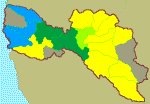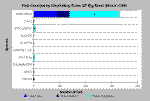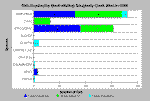Bibliography Background About KRIS
Hypothesis #1: The distribution and abundance of coho in the KRIS Big River project area has been diminished by historic and recent land use.
Support for the Hypothesis From the Literature
Although there were no early fish counts on the Big River, there are many references to the plentiful salmon resources in the press and in people's recollections captured by local literature. The book Mendocino City, A daily Journal 1852-1938 captures newspapers accounts from the town of Mendocino and contains the following notes:
December 6, 1900: Seventy-nine nice big fellows, as Nathaniel Smith seined a great haul of salmon on the river. The market was soon flooded by the salmon he was bringing to town and selling at 25 cents each.
November 15, 1902: Twenty-four salmon were caught on Big River by a young man using a trolling outfit. Described as the best run of salmon ever, it was a poor fisherman who returned empty handed. There are reports that even better catches were made.
The references to salmon and the Big River decreased as the use of splash dams in logging increased. Large areas of the basin were logged, and log drives would occur as many as four times a year, until all timber was removed. There is little of the Big River basin that is not still profoundly altered by this early land use (see History). The North Fork Big River was the last of the major sub-basins to be splash dammed and log drives continued through 1943. Basins such as Chamberlain Creek and James Creek still show signs of lingering effects of early logging and splash dams, with pools infrequent and shallow and coho salmon rarely sampled despite restrained forest harvest regimes in recent decades.
 This bedrock streambed in the upper South Fork Big River is typical of reaches scoured by the man-made debris torrents associated with splash damming. Log drives removed spawning gravels, large wood and any trees encroaching on the stream that might impede log movement. These stream reaches have low habitat complexity and carrying capacity for juvenile salmonids as a legacy of activities that took place over a century ago.
This bedrock streambed in the upper South Fork Big River is typical of reaches scoured by the man-made debris torrents associated with splash damming. Log drives removed spawning gravels, large wood and any trees encroaching on the stream that might impede log movement. These stream reaches have low habitat complexity and carrying capacity for juvenile salmonids as a legacy of activities that took place over a century ago.
Taylor (1978) estimated that the Big River had an adult coho population of 6,000 and a steelhead population of 12,000. No field data was collected in the Big River, but he noted that coho returns in the nearby South Fork Noyo River basin: "ranged from about 5,000 to 1,150 with the 15-year average being 2,570 salmon." The estimates were generated from weir counts from 1962-1977 at the California Department of Fish and Game (CDFG) Noyo Egg Taking Station, which is several miles up the South Fork. The Noyo River was also assigned a basin-wide estimate of 6,000 adult coho by Taylor (1978). See a table of adult salmon and steelhead returns for northern California streams in the 1960s.
The actual carrying capacity of the Big River may have been less than the Noyo River at that time because of extensive logging in the 1930s and 1940s in the North Fork Big River, Little North Fork and Laguna Creek. The latter two basins had railroads along their lower reaches associated with logging, which may still cause elevated sediment yields as the old road bed erodes. Many stream reports from CDFG in the 1950s and 1960s document very poor stream habitat conditions and sparse fish numbers in many Big River sub-basins as a result of lingering damage from logging activity (see KRIS Bibliography).
Daugherty Creek and the South Fork Big River, however, were logged in an earlier period and had recovered to where they harbored coho according to CDFG (1959b, 1966c). Elwell (CDFG, 1966c) surveyed the South Fork Big River and found coho salmon and steelhead very numerous and in almost equal proportions, but slightly more steelhead. Coho juveniles were estimated at 250/100 feet and steelhead at 300/100 feet. Morehouse (CDFG, 1959) said that Daugherty Creek was "the most important tributary of the South Fork of the Big River for the production of steelhead and silver salmon."
Recent fisheries data from the Mendocino Redwood Company and the Hawthorne Timber Company collected since 1994 and fish samples from the California Department of Fish and Game suggest that coho are at remnant levels or absent in much of the basin. The fish survey results of the South Fork Big River and Daugherty Creek are shown below to exemplify streams where coho have diminished or disappeared as a result of recent land use activity. The diminished range of coho in the Big River basin and sub-optimal conditions in sub-basins where they exist suggest very limited carrying capacity. Consequently, it is likely that the coho population today is down by an order of magnitude from 1960s estimates. See Hypothesis #2 for a discussion of the relationship between water temperature increases and loss of coho salmon.
Supporting Data Topics in KRIS Big River Maps and Database
The map images below, from the KRIS Big River Map project, show gradient of the Big River to indicate suitability for coho salmon, and the current balance of fish community structure between coho and steelhead. The charts below, from the KRIS Big River database, are derived from the Topics listed here. Check these Topics in KRIS to see the information in context and to have access to Info Links and Metadata.
(SF) Fish: MRC Snorkeling in South Fork Big River 1996
(DC) Fish: Basin wide Coho Dive Survey 2000
 This map image shows the stream gradient of the Big River basins. Most mainstem reaches fall into the 1-2% category, making most of the basin ideal for coho salmon (Groot and Margolis, 1991). Even the mainstems of Chamberlain Creek and Rice Creek have optimal gradient for coho salmon, although they have tributaries with greater than 20% gradients. With this much access for coho salmon, the pre-logging carrying capacity was likely to have been over 10,000 adults annually.
This map image shows the stream gradient of the Big River basins. Most mainstem reaches fall into the 1-2% category, making most of the basin ideal for coho salmon (Groot and Margolis, 1991). Even the mainstems of Chamberlain Creek and Rice Creek have optimal gradient for coho salmon, although they have tributaries with greater than 20% gradients. With this much access for coho salmon, the pre-logging carrying capacity was likely to have been over 10,000 adults annually.
 KRIS Big River project area Calwater watersheds are highlighted at left showing where 1) coho are dominant in fish samples (blue), 2) steelhead and coho salmon are co-equal (dark green), 3) steelhead are dominant but coho are still a part of the community (light green) and 4) where steelhead are the major species while coho are at remnant levels or absent (yellow). In basins where coho are in the latter category, they may be present in some years but absent in others. Areas for which recent fish data are lacking are shaded gray.
KRIS Big River project area Calwater watersheds are highlighted at left showing where 1) coho are dominant in fish samples (blue), 2) steelhead and coho salmon are co-equal (dark green), 3) steelhead are dominant but coho are still a part of the community (light green) and 4) where steelhead are the major species while coho are at remnant levels or absent (yellow). In basins where coho are in the latter category, they may be present in some years but absent in others. Areas for which recent fish data are lacking are shaded gray.
 This chart shows results of three fish counts by divers in 1996 in the South Fork Big River at sites below Daugherty Creek. None of the locations had coho salmon juveniles, probably as a result of elevated water temperatures (see Hypothesis #2). These types of fish samples, in combination with those from tributaries, are the basis for the coho salmon remnant/absent designation in the South Fork Big River. Data provided by the Mendocino Redwood Company.
This chart shows results of three fish counts by divers in 1996 in the South Fork Big River at sites below Daugherty Creek. None of the locations had coho salmon juveniles, probably as a result of elevated water temperatures (see Hypothesis #2). These types of fish samples, in combination with those from tributaries, are the basis for the coho salmon remnant/absent designation in the South Fork Big River. Data provided by the Mendocino Redwood Company.
 1996 fish samples in Daugherty Creek are shown at left. Although coho were present above Gates Creek, they were absent from lower and upper Daugherty Creek sites. Samples taken in all other years (1994, 1995, 2000) show no coho present, which makes this stream fall into the category of coho remnant/absent. Data provided by the Mendocino Redwood Company.
1996 fish samples in Daugherty Creek are shown at left. Although coho were present above Gates Creek, they were absent from lower and upper Daugherty Creek sites. Samples taken in all other years (1994, 1995, 2000) show no coho present, which makes this stream fall into the category of coho remnant/absent. Data provided by the Mendocino Redwood Company.
Alternate Hypotheses
The observed change in the distribution and abundance of coho juveniles is within the natural range of variability and has nothing to do with land use activity.
This alternative hypothesis might offer fishing, ocean conditions or predation by marine mammals as the cause of coho salmon decline, not human-caused habitat change. Given the lack of adult coho salmon data, some interests have challenged whether any decrease in the coho population has occurred.
Monitoring Trends to Test the Hypotheses
Improved coho juvenile estimates in conjunction with adult carcass or redd counts are needed to test whether coho populations rebound, continue to decline or disappear. As habitat recovers, with streams becoming deeper and cooler, relationships between increased carrying capacity and coho populations could be tested. Genetic tests of the existing the Big River coho population could help to determine its long-term viability.
References
California Department of Fish and Game (CDFG). 1959b. Daugherty Creek (South Fork Big River tributary) stream survey, 10 August 1959. CDFG unpublished file memo by J. Morehouse. Yountville, CA. 6 pp.
California Department of Fish and Game (CDFG). 1966c. South Fork Big River (Big River tributary) stream survey, 25 August 1966. CDFG unpublished file memo by B. Edie. Yountville, CA. 5 pp.
Jackson, W. Francis. 1988. Mendocino City, A daily Journal 1852-1938. Mendocino Historical Research, Inc. Mendocino, CA.
Groot, C. and L. Margolis (Eds). 1991. Pacific Salmon Life Histories. University of British Columbia Press, Vancouver, Canada. 561 p.
Taylor, S.N. 1978. The status of salmon populations in California coastal rivers. California Department of Fish and Game. Salmon/Steelhead Program, Anadromous Fisheries Branch. 14 pp.